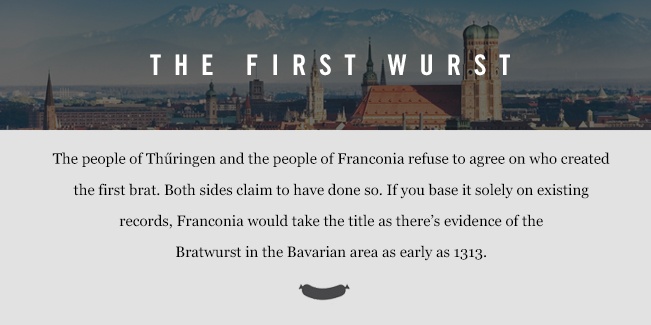
Oktoberfest might be synonymous with liters of beer, but you’ll need some hearty food to keep your head on straight when you’re celebrating with those malty beverages. While you could go with an enormous soft pretzel, we like to order up a platter of wurst (sausage). And if your knowledge of German sausage is limited to some basic brats, there’s a whole wurst world out there for you to experience. Here’s a rundown of some of the different kinds.

Bratwurst
Despite what you might think, there isn’t just one Bratwurst. The classic style of wurst varies region to region and is made from veal, pork, or beef, and is pan-fried or grilled. They can take on different shapes, tastes, and compositions throughout the country, but should contain little seasoning.

Bierwurst
Yes, bier means beer, but don’t be fooled into thinking this sausage is simply cooked in some ale. Bierwurst gets its name because it used to often be paired with a cold brew. It’s actually made with pork, beef, and heart (sometimes), and seasoned with black pepper, mustard seeds, and paprika.

Knackwurst
Knackwurst, or ‘Knockwurst’ as it’s often written in the U.S., is usually chubby and short and includes garlic in the mixture. Knacken means “to crack,” and the skin on a knackwurst should deliver a satisfying snap when you bite into it. The more heavily seasoned knackwurst is aged for a few days and smoked. Commonly served with sauerkraut and potato salad.

Bockwurst
Bockwurst gets its name because it was traditionally washed down with a bock beer. Commonly made with a mixture of veal and pork (more veal than pork), the wurst gets a flavor boost from the addition of paprika and sometimes chives and parsley. Like many others, Bockwurst is often served with mustard.

Weisswurst
If you want an Oktoberfest wurst, this is the one you want. The Bavarian Weisswurst is made from veal and pork and is white in color. It is usually heavily seasoned with onions, lemon, parsley, and cardamom. They’re cooked in a hot water bath and served with sweet mustard. It’s a Bavarian specialty.

Blutwurst
Blutwurst (blood sausage) is made, as the name would suggest, with blood from a pig. Like Weisswurst, most Blutwurst is warmed in hot water before serving, larger ones, however, are sometimes enjoyed cold.


Nuremberg Rostbratwurst
One of the most famous variations of the classic brat is this one you can get on the streets of Nuremberg. The tinier Nuremberg bratwursts are often sold in threes on a hard roll and have a pronounced marjoram taste. They resemble American breakfast links.

Currywurst
Walk into a German grocery store and you’ll see bottles of curry ketchup, and while you can use it for a lot of stuff, this is what it’s designed for. Currywurst is a steamed then fried pork sausage that gets cut up into pieces and topped with curry ketchup. As more of a fast food wurst, it’s commonly served with fries on the side.

Gelbwurst
Literally meaning “yellow sausage,” Gelbwurst was created in the early 1900s by combining pork and veal with ginger, nutmeg, and brains. While it no longer contains brains, Gelbwurst is still popular. The meat mixture is very smooth and makes Gelbwurst ideal to consume like other cold cuts. It’s a very mild tasting wurst.

Leberwurst
You know it as liverwurst, the spreadable sausage made with pigs’ or calves’ liver. Perhaps it haunted your childhood. There are many different varieties throughout Germany, though most contain veal, fat, and a variety of spices. You’ll often find it served on open-faced sandwiches with mustard.

Teewurst
Teewurst is made from pork, bacon, and sometimes beef. Each link is smoked over beechwood and allowed to sit and develop flavor. The high fat content makes it ideal for spreading. The sausage gets its name because sandwiches with it used to be served with tea.


Mettwurst
A minced pork-based wurst meant for spreading like Teewurst (some areas of Germany do serve harder Mettwurst).

Wollwurst
This sausage is made without a casing and is boiled before being chilled. The process gives the wurst its signature “wooly” look.

Frankfurter
Wurstchen
The precursor to the hot dog. They date back to the 13th century and were originally made with just pork in Frankfurt. As its popularity spread, beef frankfurters became more common.

Bregenwurst
It used to be made of pork and brains (the brains are no longer an ingredient), Bregenwurst is a specialty of Lower Saxony and is commonly served with kale.

Landjäger
Dried wurst made from beef, pork, fat, and seasoning. It looks like a large Slim Jim or a small salami.




